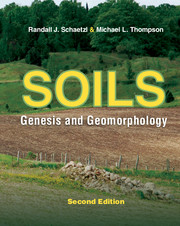2 - Basic Concepts: Soil Morphology
Published online by Cambridge University Press: 12 January 2024
Summary
What Is Soil?
Soil means different things to different people. To a farmer or horticulturalist, it is a medium for plant growth. To an engineer, it is something to build on, or remove, before construction can occur, or it may actually be a type of medium used for road building, house foundations, or septic drain fields. To a hydrologist, soil functions as a source of water purification and supply. To some geologists, it is the post- Pliocene overburden that is covering up the rocks!
We use a slightly modified statement from the one offered by Johnson (1998a) as the best and most widely applicable definition of soil: Soil is organic or lithic material, normally at the surface of planets and similar bodies, that has been altered by biological, chemical, and/or physical agents. This definition and the one proposed by Richter and Markewitz (1995) – “Soil is the biologically excited layer of the Earth's crust” – give equal rank to biological processes and agents, which were ignored by some previous definitions that focused on the physical and chemical processes of soil formation. Pedologists and soil geographers often use a similar definition: A soil is a natural, threedimensional body that has formed at the Earth's surface through the interactions of at least five soil-forming factors (climate, biota, relief or topography, parent materials, and time). This definition emphasizes that soils are “naturally occurring” bodies and introduces the five soil-forming factors into the equation, front and center. All of these definitions have merit and fit with the ways in which soils are discussed in this book.
Soils are composed of clastic particles (mineral matter), organic materials in various stages of decay, living organisms, water (or ice), and gases within pores of various sizes (Fig. 2.1). The absolute amounts of each, and their arrangement into a particular fabric, are the sum of soil morphology. Every soil has a distinct morphology, defined as its structure or form. Soil morphology is all that can be seen and felt about a soil. It includes not only “what is there” but also how it is “put together” – its architecture. To many, the main components of soil morphology include horizonation, texture, color, redoximorphic features, porosity, structure, and consistence, i.e., the look and feel of the soil.
- Type
- Chapter
- Information
- SoilsGenesis and Geomorphology, pp. 8 - 28Publisher: Cambridge University PressPrint publication year: 2015



